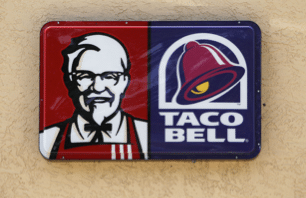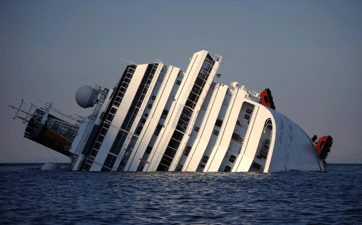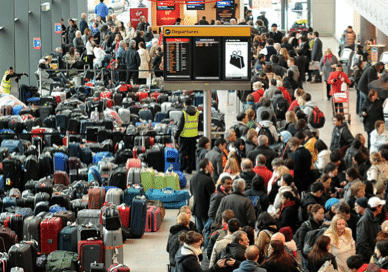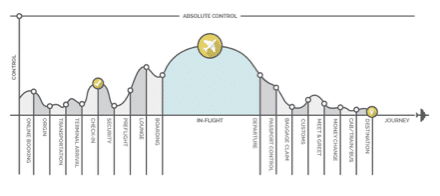Last week we saw what touchpoint shape a brand experience (read the article here). The degree to which a brand experience can be managed is a function of how much control can be exercised over that experience.
Control is the challenge. Some things can be absolutely controlled, others things can only be influenced, and still others we can only hope for the best. Understanding what you can’t control, however, is as important as understanding what you can. The cold reality – in managing the brand experience: weather isn’t the only thing you can’t control.
5 examples of “out of control” situations brands must consider
1. Unpredictable behavior
You can’t predict how someone will behave.
Brick-and-mortar retailing is a highly controlled brand experience. At a Nike Town store, Nike can control the interior design features (store layout, materials and finishes, lighting, fixtures, displays and colors), their product mix, display, and promotion, checkout process and customer amenities.
The one thing Nike cannot totally dictate is employee behavior. Regardless of the screening, training and experience, employees are still human and there is always a degree of uncertainty as to their response to certain situations, mood, or other factors that affect their behavior.
To finish, although the brick-and-mortar retailing generally falls into a high-level control experience within the store, what happens outside the store environment is, of course, another matter.
2. Nature will take its course
You can’t control the weather.
Service industries are highly vulnerable to influences outside the control of the brand. These outside forces can play a key role in determining whether the experience is brand reinforcing or undermining.
FedEx, for example, is a brand that is heavily influenced by factors outside its control. Weather, road conditions and traffic can all influence the ability to fulfill customer expectations regardless of investment in logistics, equipment and personnel. The direct point of contact is at the beginning and end of a process, in between which any number of things can happen that will affect the impression, reliability, trust and loyalty toward the brand. In the end:
Customers will only remember if their package gets to their destination on time… they will remember it longer if it doesn’t.
3. Unintended consequences
Your partners may not always be what you want them to be.
Partnering with other brands can lead to unexpected consequences relative to managing the brand experience. In co-branding or ingredient branding situations, the partner brands do not necessarily have any control over the other, but they can certainly influence the perceptions of their partner brand by virtue of that association. There are risk/reward considerations. Although Intel, as an ingredient brand, adds value to its host computer, a bad experience with the computer can cast a shadow over impressions associated with Intel.
Although combining a KFC, A&W and Taco Bell into one location can be operationally efficient, it begs the question as to whether the cohabitation of those brands makes sense from a consumer point of view. Do the perceptions around a bucket of chicken complement the perceptions associated with a taco?
4. Casting a giant shadow
You have to live with your industry brand.
Industry brand perceptions can also influence the impressions of any and all brands within that industry. Regardless of how exquisite or luxurious an individual cruise ship experience might be, the Costa Concordia and other cruise-related incidents have dramatically influenced the perceptions associated with the industry and ultimately the individual brands in that industry. The BP oil spill did nothing to help the petroleum retailers’ image. Volkswagen’s attempt to rig pollution testing certainly added to credibility questions around the auto industry already tainted by countless recalls.
Some industries unfortunately consistently rank among the worst in customer service. According to Temkin’s Customer Service Ratings in 2014 on trust and forgiveness, TV, Internet and health providers were among the worst.1 Brands within those industries have to not only manage their own brand experience but also cope with perceptions associated with their industry.
5. Turbulent journey
The longer the journey that greater the chances are that a lot more will go wrong at any point in that journey.
The example of Emirate Airlines:
The ideal experience:
Waking up at the end of a long international flight and not finding an on-board shower spa can be a travel nightmare experience for some. At least that’s what the recent Emirates Airlines commercials portray. Of course, only a tiny fraction of the passengers are going to experience anything like this. Emirates is banking that this ideal luxury travel experience will have a halo effect that will elevate the perceptions associated with the airline. The hope is that the other 99% of the passengers who will not have access to the on-board shower spa will still feel pampered, at least in some more modest way.
While this would certainly not be representative of the more typical air travel experience, it does show the lengths that an airline can and will go to create a unique experience in an environment in which it has a high level of control.
What can affect the ideal experience:
While onboard, the airline can control how comfortable it is, the food it serves, the kind of entertainment available, the level of service, and many other features that contribute to the experience. The airline can affect many of the touchpoints onboard the aircraft through design, operations and training. However, it can’t control the weather turbulences, crying babies, or annoying passengers—even in first class.
The real challenge comes before takeoff and after landing. Consider the passenger journey upon arriving at the airport beginning at curbside and extending through to boarding. Of the hundreds, if not thousands of touchpoints in that journey, the airline has control on only a few.
There are over a hundred touchpoints at the international check-in counter alone if you consider everything from the interior environment, the counter, the check-in protocol, airline personnel behavior, documents, baggage claim tickets, boarding passes, folders, etc. All of those touchpoints will have an influence on the perception of the brand journey for better or for worse.
What the brand journey chart below illustrates is the typical path that an international airline traveler takes between the arriving and departing terminals. It shows how the degree of control can vary across that path and how vulnerable the brand experience is to those factors outside the control of the brand.
Even with those touchpoints where there is a relatively high degree of control, the experience is still subject to any number of things that can go wrong. No matter how hard the airline tries, the passenger recollection of waiting for an hour to retrieve luggage, being hassled at customs or unable to find a cab will contribute to shaping the experience.
Experience Matters.
Next: Part 3 – Coping with what you can’t control!
References: 1Temkin Customer Service Ratings 2014, Emirates.com

















